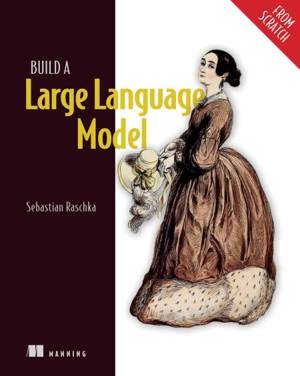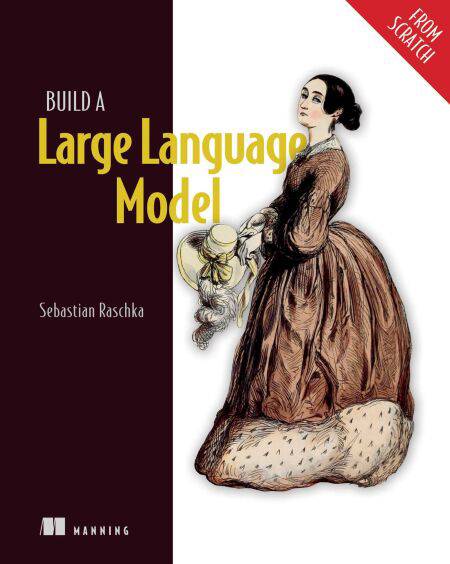
- Afhalen na 1 uur in een winkel met voorraad
- Gratis thuislevering in België vanaf € 30
- Ruim aanbod met 7 miljoen producten
- Afhalen na 1 uur in een winkel met voorraad
- Gratis thuislevering in België vanaf € 30
- Ruim aanbod met 7 miljoen producten
Zoeken
€ 49,20
+ 49 punten
Omschrijving
Learn how to create, train, and tweak large language models (LLMs) by building one from the ground up!
In Build a Large Language Model (from Scratch) bestselling author Sebastian Raschka guides you step by step through creating your own LLM. Each stage is explained with clear text, diagrams, and examples. You’ll go from the initial design and creation, to pretraining on a general corpus, and on to fine-tuning for specific tasks.
Build a Large Language Model (from Scratch) teaches you how to:
• Plan and code all the parts of an LLM
• Prepare a dataset suitable for LLM training
• Fine-tune LLMs for text classification and with your own data
• Use human feedback to ensure your LLM follows instructions
• Load pretrained weights into an LLM
Build a Large Language Model (from Scratch) takes you inside the AI black box to tinker with the internal systems that power generative AI. As you work through each key stage of LLM creation, you’ll develop an in-depth understanding of how LLMs work, their limitations, and their customization methods. Your LLM can be developed on an ordinary laptop, and used as your own personal assistant.
About the technology
Physicist Richard P. Feynman reportedly said, “I don’t understand anything I can’t build.” Based on this same powerful principle, bestselling author Sebastian Raschka guides you step by step as you build a GPT-style LLM that you can run on your laptop. This is an engaging book that covers each stage of the process, from planning and coding to training and fine-tuning.
About the book
Build a Large Language Model (From Scratch) is a practical and eminently-satisfying hands-on journey into the foundations of generative AI. Without relying on any existing LLM libraries, you’ll code a base model, evolve it into a text classifier, and ultimately create a chatbot that can follow your conversational instructions. And you’ll really understand it because you built it yourself!
What's inside
• Plan and code an LLM comparable to GPT-2
• Load pretrained weights
• Construct a complete training pipeline
• Fine-tune your LLM for text classification
• Develop LLMs that follow human instructions
About the reader
Readers need intermediate Python skills and some knowledge of machine learning. The LLM you create will run on any modern laptop and can optionally utilize GPUs.
About the author
Sebastian Raschka, PhD, is an LLM Research Engineer with over a decade of experience in artificial intelligence. His work spans industry and academia, including implementing LLM solutions as a senior engineer at Lightning AI and teaching as a statistics professor at the University of Wisconsin–Madison.
Sebastian collaborates with Fortune 500 companies on AI solutions and serves on the Open Source Board at University of Wisconsin–Madison. He specializes in LLMs and the development of high-performance AI systems, with a deep focus on practical, code-driven implementations. He is the author of the bestselling books Machine Learning with PyTorch and Scikit-Learn, and Machine Learning Q and AI.
The technical editor on this book was David Caswell.
Table of Contents
1 Understanding large language models
2 Working with text data
3 Coding attention mechanisms
4 Implementing a GPT model from scratch to generate text
5 Pretraining on unlabeled data
6 Fine-tuning for classification
7 Fine-tuning to follow instructions
A Introduction to PyTorch
B References and further reading
C Exercise solutions
D Adding bells and whistles to the training loop
E Parameter-efficient fine-tuning with LoRA
In Build a Large Language Model (from Scratch) bestselling author Sebastian Raschka guides you step by step through creating your own LLM. Each stage is explained with clear text, diagrams, and examples. You’ll go from the initial design and creation, to pretraining on a general corpus, and on to fine-tuning for specific tasks.
Build a Large Language Model (from Scratch) teaches you how to:
• Plan and code all the parts of an LLM
• Prepare a dataset suitable for LLM training
• Fine-tune LLMs for text classification and with your own data
• Use human feedback to ensure your LLM follows instructions
• Load pretrained weights into an LLM
Build a Large Language Model (from Scratch) takes you inside the AI black box to tinker with the internal systems that power generative AI. As you work through each key stage of LLM creation, you’ll develop an in-depth understanding of how LLMs work, their limitations, and their customization methods. Your LLM can be developed on an ordinary laptop, and used as your own personal assistant.
About the technology
Physicist Richard P. Feynman reportedly said, “I don’t understand anything I can’t build.” Based on this same powerful principle, bestselling author Sebastian Raschka guides you step by step as you build a GPT-style LLM that you can run on your laptop. This is an engaging book that covers each stage of the process, from planning and coding to training and fine-tuning.
About the book
Build a Large Language Model (From Scratch) is a practical and eminently-satisfying hands-on journey into the foundations of generative AI. Without relying on any existing LLM libraries, you’ll code a base model, evolve it into a text classifier, and ultimately create a chatbot that can follow your conversational instructions. And you’ll really understand it because you built it yourself!
What's inside
• Plan and code an LLM comparable to GPT-2
• Load pretrained weights
• Construct a complete training pipeline
• Fine-tune your LLM for text classification
• Develop LLMs that follow human instructions
About the reader
Readers need intermediate Python skills and some knowledge of machine learning. The LLM you create will run on any modern laptop and can optionally utilize GPUs.
About the author
Sebastian Raschka, PhD, is an LLM Research Engineer with over a decade of experience in artificial intelligence. His work spans industry and academia, including implementing LLM solutions as a senior engineer at Lightning AI and teaching as a statistics professor at the University of Wisconsin–Madison.
Sebastian collaborates with Fortune 500 companies on AI solutions and serves on the Open Source Board at University of Wisconsin–Madison. He specializes in LLMs and the development of high-performance AI systems, with a deep focus on practical, code-driven implementations. He is the author of the bestselling books Machine Learning with PyTorch and Scikit-Learn, and Machine Learning Q and AI.
The technical editor on this book was David Caswell.
Table of Contents
1 Understanding large language models
2 Working with text data
3 Coding attention mechanisms
4 Implementing a GPT model from scratch to generate text
5 Pretraining on unlabeled data
6 Fine-tuning for classification
7 Fine-tuning to follow instructions
A Introduction to PyTorch
B References and further reading
C Exercise solutions
D Adding bells and whistles to the training loop
E Parameter-efficient fine-tuning with LoRA
Specificaties
Betrokkenen
- Auteur(s):
- Uitgeverij:
Inhoud
- Aantal bladzijden:
- 368
- Taal:
- Engels
- Reeks:
Eigenschappen
- Productcode (EAN):
- 9781638355731
- Verschijningsdatum:
- 28/10/2024
- Uitvoering:
- E-book
- Beveiligd met:
- Adobe DRM
- Formaat:
- ePub

Alleen bij Standaard Boekhandel
+ 49 punten op je klantenkaart van Standaard Boekhandel
Beoordelingen
We publiceren alleen reviews die voldoen aan de voorwaarden voor reviews. Bekijk onze voorwaarden voor reviews.











